Time for some childhood nostalgia: raspberry soup, or hallonkräm. My mother made tasty sweet soups of all kinds for our snack time — rhubarb, raspberry, apple — but sometimes, we kids would make the soups using a ready-made powder.
And the commercials for ready-made soups make the most out of this nostalgia, as in this 90s commercial from Ekströms.
The origins of Swedish raspberry soup
We’ll start in the 17th century if we can, right? Making sweet soup, called soppa (thinner) or kräm (thicker) in Swedish, is hardly something complicated enough that it mandates a recipe. But, we can still find one in the chapter on soups in En gammal svensk kokbok from 1650. “To cook with blackcurrants” — “att koka med svarta vinbär” — is a berry soup made of currants, sweet wheat bread and wine. You sweeten the soup and flavor it with cinnamon.
According to Per Brahe den yngres Visingsborg by Ingrid Larsson Haglund, cherry compote or cherry soup were popular dishes in the 17th century. A recipe for cherry soup from the 17th century cookbook said to belong to county Per Brahe sounds more like a compote. You start by frying rye bread in butter and then layer it with cherries, spices, and butter, and cook it.
These two recipes can hardly speak for the entire century, but both of the sweet soups contain bread. Grated bread was a common ingredients in all kinds of soups, both the savoury and the sweet ones.
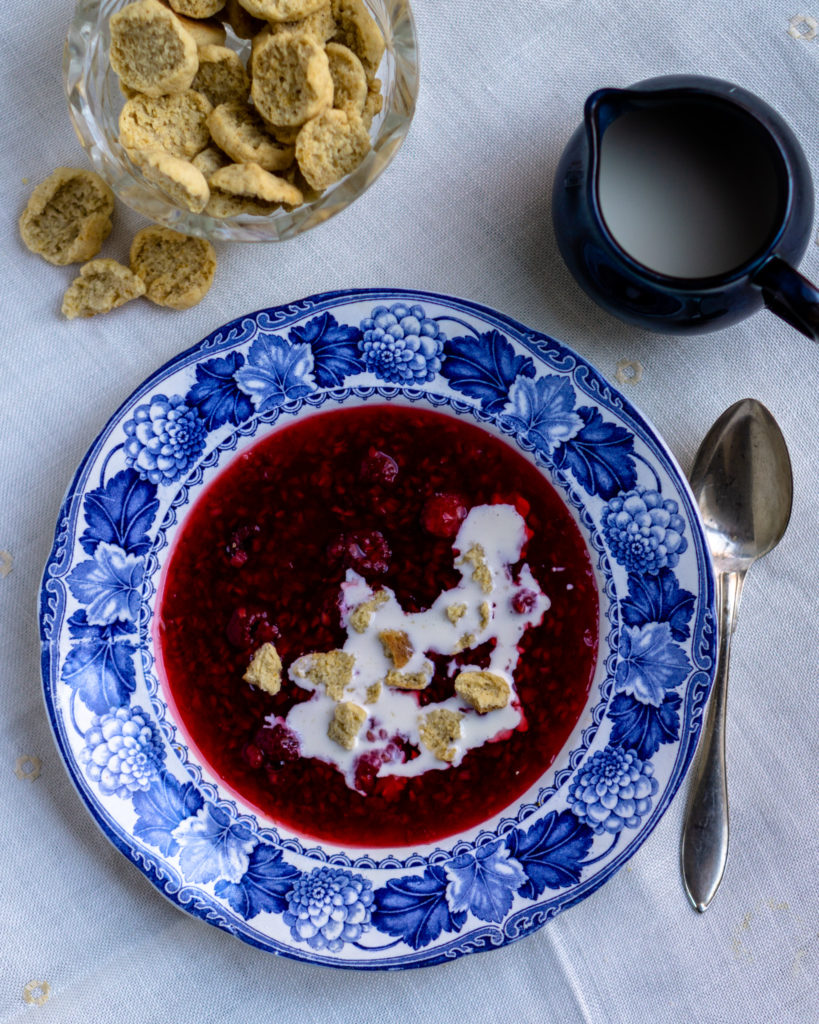
Berry soup à la Cajsa Warg in the 18th century
When we look at Cajsa Warg’s 1755 cookbook, there are several recipes for soups: rosehips, “thébou” (?), chocolate, berries, bitter orange, and apple. Not bad! However, Warg’s berry soup is milk-based. After heating, spicing and thickening the milk, you let it cool and then stir berry cordial into it.
Warg’s cookbook had a great influence on other Swedish cookbooks and recipe writing at the time. The handwritten recipe collection of Ulrika Eleonora Munck (1770s) also includes a recipe for berry soup — and it is pretty much an exact copy of Warg’s. According to Karin Sidén who edited Munck’s cookbook for publication, samples show that Munck’s cookbook isn’t a direct copy of the printed cookbooks at the time. However, when it comes to the berry soup, I mean that Munck or the person she got the recipe from must have copied it from Cajsa Warg’s cookbook (I compared the 1755 edition).
Over to sweet soups in the 19th century
Gustafwa Björklund’s 1847 cookbook has an entire recipe dedicated to “crèmer” — however, no raspberry soup, my favorite. The recipes do not only consist of berry cordial soup, wild strawberry soup, and cherry soup but also various oven-baked crèmes such as lemon cream meringue and warm versions such as an arrack cream. Some of the recipes are poured into “crystal bowls” to set and be served with sweet rusks and cream.
What the Swedes today refer to as krämer (“creams”) or soppor are mostly fruit- or berry based. However, many of the thick sweet soups during the 18th and 19th centuries are milk-based. C.E. Hagdahl (1896) describes in his chapter on “creams” how they often consist of cream, egg, sugar, and some essence, plus a thickener such as gelatine. Hagdahl admits, however, that there also are creams of wine or fruit cordial instead of cream.
Hagdahl happily divides his krämer into “firm creams with substance”, crèmes françaises, who set in little ramekins, and crèmes anglaises, who are “loose creams without substance” who set in ramekins in bain marie. The loose creams can be used as fillings in cakes or served as independent dishes, served with macarons, sweet rusks, or candied fruits. We’ll have to dive deeper into this in another article, but we can see that the cream or sweet soup recipes during the 19th century were numerous and, at times, rather advanced.
For his “raspberry cream in cups — pots de crème aux framboises” Hagdahl uses raspberry cordial, red currant cordial, sugar, and… 12 eggs. But he also includes simpler dishes. For använder Hagdahl hallonsaft, vinbärssaft, socker och — 12 ägg. Men han har även förståelse för enklare rätter. Hagdahl mentions that you also can make “cream or berry porridge” from fresh or dried berries, but then you have to crush, press and boil the berries to turn them into a cordial.
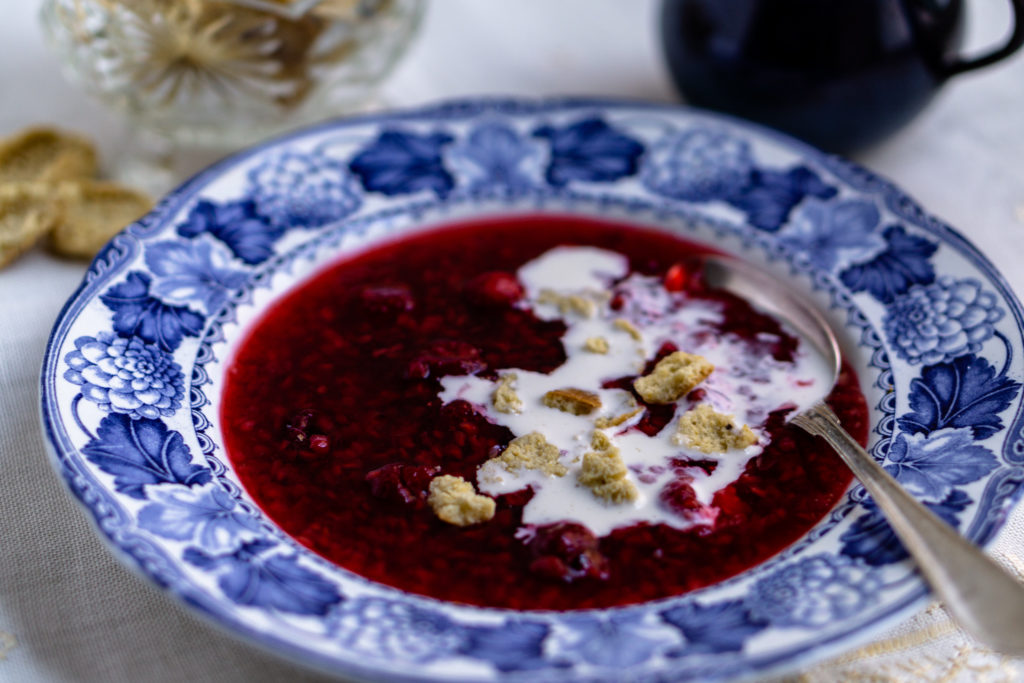
The berry soups of the country people
Hagdahl may have wanted to turn the berries into cordial before they became berry soup, but his cookbook is mostly for those with means. Berry soup wasn’t necessarily made of cordial. In Svensk Allmogekost (1919, mostly about the mid-19th to the early 20th century), Nils Keyland writes about different kinds of bärgröt, or berry porridges, from Gotland.
In the Kräklingbo area on Gotland, people apparently ate blueberry porridge, gooseberry porridge, cordial porridge and rhubarb porridge. Based on the listed ingredients, we can see that these “porridges” or thick soups consisted of fresh or dried berries (or cordial), water, and sugar or syrup. They were thickened with potato starch. It sounds a lot like today’s sweet fruit or berry soups, right?
Berry soup as a popular dessert during the 20th century
Sweet soups used to be popular as desserts. It is more often called soup than kräm, or cream. From the articles in Svenska Dagbladet during the 20th century, we can see that it came in an array of flavors: strawberry, blueberry, apricot, cherry, orange, chocolate, rosehip, lemon, “fruit”, and raspberry.
Detailed menu suggestions show readers of Svenska Dagbladet what they could eat for breakfast, lunch, and dinner during the coming week. Based on the suggestions, we can see that dinner was supposed to come with dessert — several times per week.
Well, this might not have been possible for all readers, for economical or health reasons, but we can at least see it as an idea of the expectations of the time. For example, in October in 1926, smooth apricot soup with sweet rusks was considered a suitable Thursday dessert:
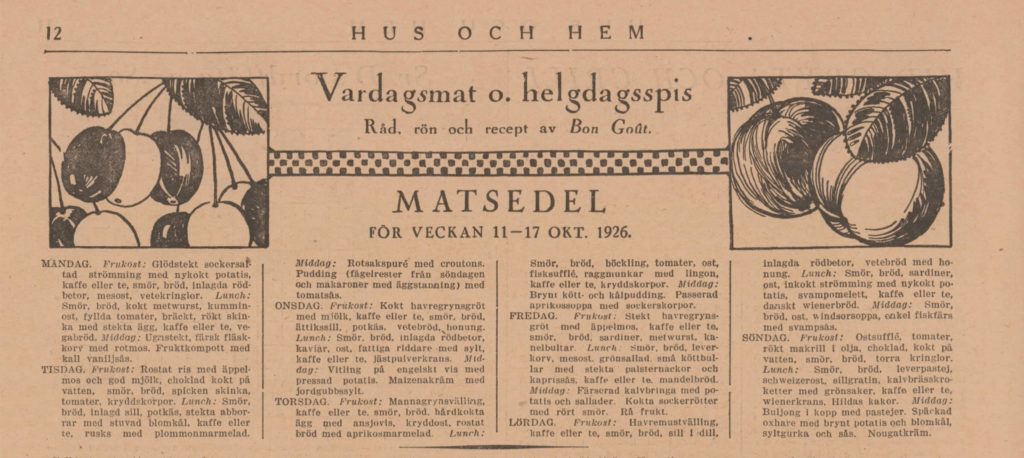
The 60s and 70s — time for simpler desserts
According to Lena Katarina Svanberg in Till bords under 100 år, it’s mainly during the 60s that a healthy diet and dieting becomes popular. An overview of the menu suggestions in Svenska Dagbladet shows that “fruit, cheese, and bread” became increasingly common in the menu suggestions during the 60s.
During the 70s, the desserts become even simpler — fresh fruit, fruit sallad or fruit preserves become popular. These simple fruit desserts gain on the cooked desserts that demand more work. Because, how often do you make a banana mousse?
As women start to work more rather than be home with the children, it’s natural that the time spent on cooking decreases. When the pressure to deliver dessert with pretty much every dinner disappeared, it’s not strange that the Swedes eat less fruit and berry soups before.
My perception is that fruit and berry soups today are considered more a snack for children than a decent, casual dessert. Too bad. However, the raspberry soup is just as tasty today as it used to be in the childhood…
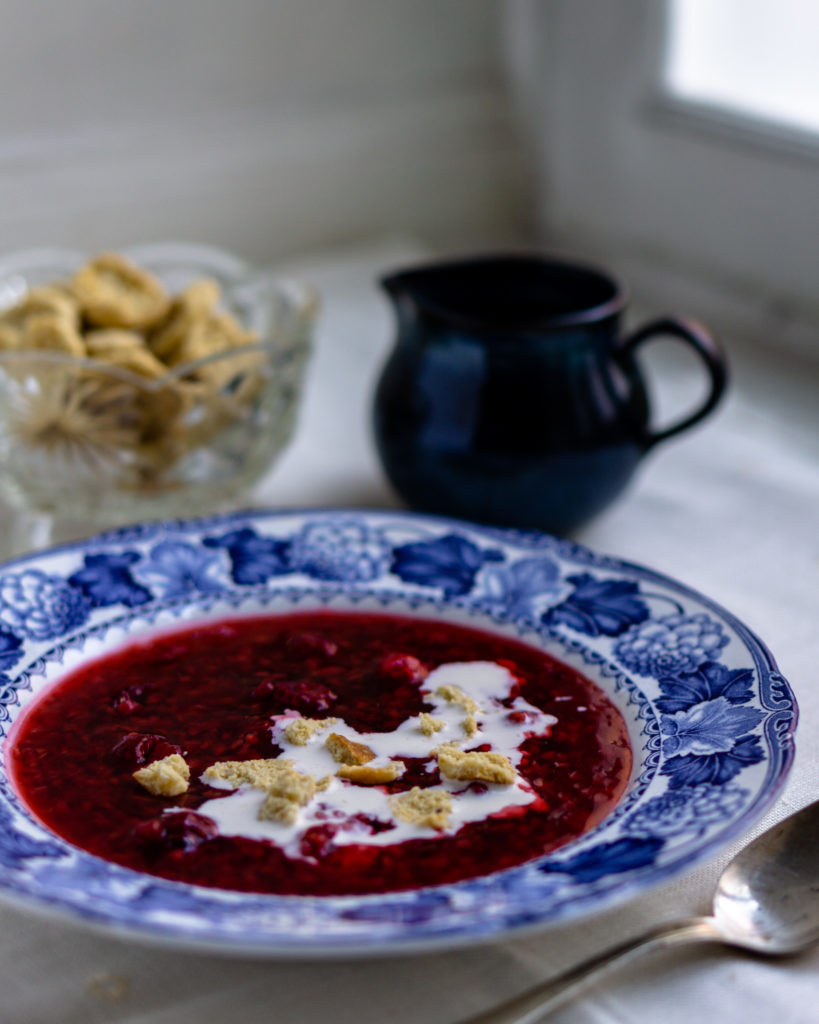
How to make classic Swedish raspberry soup — bärkräm
There are many recipes based on a strong cordial, but also many more luxurious versions made of whole berries. Personally, I feel it would be a waste of fresh raspberries to make this (enjoy them as they are, unless you have never-ending supplies) — after all, frozen berries work just as well. You can serve the soup warm or cold as a dessert or a snack. For four small portions:
Ingredients
5 dl or about 225 g (2 cups or 8 oz) raspberries — frozen works well
3 dl (1 1/4 cups) water
3-5 tbsp sugar + 1 tbsp to sprinkle on top at the end
2-2 1/2 tbsp potato starch + 3 tbsp water
Instructions
- Stir together raspberries, water, and the smaller amount of sugar in a saucepan and bring it to a boil.
- Heat the mix on medium heat for a few minutes. Stir the potato starch into 3 tbsp water and pour it into the soup as you are stirring the soup. Keep stirring as you bring the soup to a boil and remove it from the heat as soon as it has thickened. Taste to see if the soup is sweet enough for your preferences. If you want a thicker soup — the Swedish one is quite thick — repeat with a little more potato starch mixed into water until you get the right consistency.
- Pour the berry soup into a nice bowl and sprinkle sugar on top so the soup won’t form a film. Eat and enjoy it warm or cold.
Suggestions
You can serve the soup however you like. The classic way of serving it is with sweet rusks or almond macaroons, as well as milk or cream. The soup is just as tasty warm as cold.
You get an even more beautiful soup if you reserve about 1 dl or 1/4 cups of the berries and stir them into the soup just as it is finished. However, make sure you have good berries that you don’t need to boil — fresh ones should be okay. In Sweden, Livsmedelsverket recommends that you boil all frozen berries that come from outside of Sweden for health and safety reasons.
Do you want some extra flavor? Vary the soup however you like with citrus peel, vanilla, or why not cardamom. You can also use other berries for the soup — raspberries and blueberries together (like queen’s jam) is a favorite.

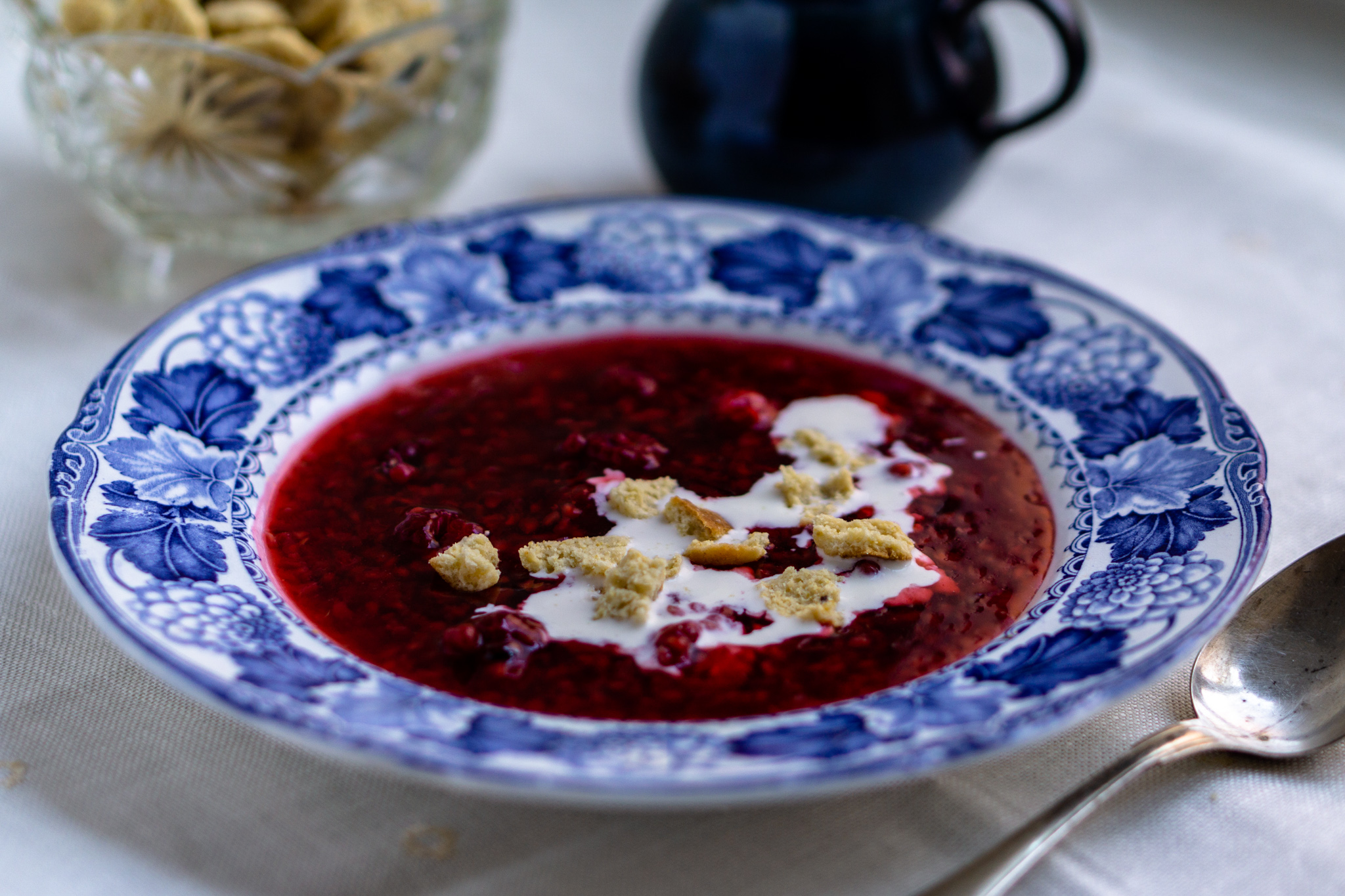

In Rainier Oregon, growing up with lots of Scandinavians of course, I’ve eaten rhubarb soup with bread for dinner. But raspberries, blackberries, and more have always been on our plates and canned in our larder for future meals. I shall delight in making this with frozen berries, and I think I shall add almond macaroons for now.
I do wish to do up some sweet rusks but I don’t have much time at the moment. My wife Linae enjoys the “fruit of my labors” especially when I cook up your recipes. Thank you!
Gregory, how interesting to hear about you having rhubarb soup for dinner — I know it used to be much more common than it is today. Still as delicious, though!
I am sure your wife is very happy with all your cooking!